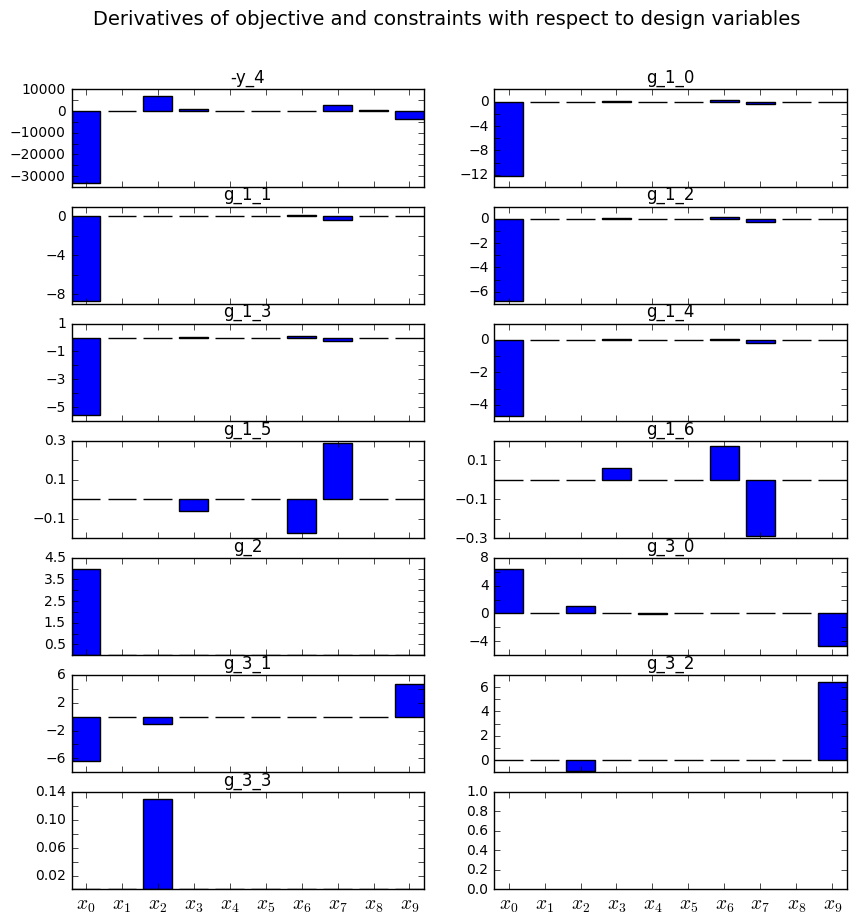Gradient sensitivity¶
Preliminaries: instantiation and execution of the MDO scenario¶
Let’s start with the following code lines which instantiate and execute the MDOScenario :
from gemseo.api import create_discipline, create_scenario
formulation = 'MDF'
disciplines = create_discipline(["SobieskiPropulsion", "SobieskiAerodynamics",
"SobieskiMission", "SobieskiStructure"])
scenario = create_scenario(disciplines,
formulation=formulation,
objective_name="y_4",
maximize_objective=True,
design_space="design_space.txt")
scenario.set_differentiation_method("user")
algo_options = {'max_iter': 10, 'algo': "SLSQP"}
for constraint in ["g_1","g_2","g_3"]:
scenario.add_constraint(constraint, 'ineq')
scenario.execute(algo_options)
GradientSensitivity¶
Description¶
The GradientSensitivity post processing builds histograms of derivatives of objective and constraints
The plot method considers the derivatives at the last iteration. The iteration can be changed in option. The x- and y- figure sizes can also be modified in option. It is possible either to save the plot, to show the plot or both.
Options¶
extension,
str- file extensionfigsize_x,
int- size of figure in horizontal direction (inches)figsize_y,
int- size of figure in vertical direction (inches)file_path,
str- the base paths of the files to exportiteration,
int- the iteration to plot sensitivities, if negative, use optimumsave,
bool- if True, exports plot to pdfshow,
bool- if True, displays the plot windows
Case of the MDF formulation¶
To visualize the gradient sensitivity plot of the scenario,
we use the execute_post() API method with the keyword "GradientSensitivity"
and additional arguments concerning the type of display (file, screen, both):
scenario.post_process(“GradientSensitivity”, save=True, show=False,file_path=“mdf” )
The figure Gradient sensitivity on the Sobieski use case for the MDF formulation shows the total derivatives of the objective and constraints with respect to the design variables: \(\frac{d f}{d x_i}\):
a large value means that the function is sensitive to the variable,
a null value means that, at the optimal solution, the function does not depend on the variable,
a negative value means that the function decreases when the variable is increased.

Gradient sensitivity on the Sobieski use case for the MDF formulation¶
\(x_0\) (wing-taper ratio) and \(x_2\) (Mach number) appear to be the most important for the gradient of the objective function.
The g_1_0 to g_1_4 are very similar, since they all quantify the
stress in various sections. g_1_5 and g_1_6 correspond to the
lower and upper bounds of the twist , therefore their sensitivities are
opposite. g_2 is a function of only \(x_0\) ; \(x_0\) is the
only variable that influences its gradient.
